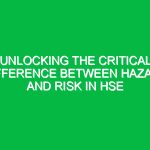Introduction
Hello team! Today, we are conducting a toolbox talk focused on an important topic in our Health, Safety, and Environment (HSE) discussions: Struck-by Incidents. These types of incidents are among the leading causes of workplace injuries and fatalities, and it’s crucial for everyone here to understand what they are, how they can be prevented, and the role each of you plays in maintaining a safe work environment.
What are Struck-by Incidents?
Struck-by Incidents refer to situations where a person is hit by an object. This can involve various scenarios, such as being struck by falling tools, flying debris, or moving vehicles. In the workplace, these incidents can occur for numerous reasons, including improper handling of equipment, lack of Personal Protective Equipment (PPE), or simply a lapse in attention. Understanding these incidents is vital for minimizing risk and ensuring Safety on the job site.
Types of Struck-by Incidents
There are several categories of Struck-by Incidents you should be aware of:
- Moving Vehicles: This includes incidents involving forklifts, trucks, and other machinery.
- Falling Objects: Tools or materials that fall from heights can cause serious injuries.
- Flying Objects: This can include debris propelled by machinery or tools.
- Swinging Objects: Tools or equipment that swing can strike workers if not used properly.
The Importance of Understanding Struck-by Incidents
Understanding Struck-by Incidents is not just about recognizing potential Hazards; it’s about fostering a culture of Safety within our organization. When every employee can identify risks and understand the consequences of these incidents, we collectively contribute to a safer workplace.
Statistics indicate that struck-by incidents account for a significant portion of workplace injuries. By being proactive and educated about these Hazards, we can reduce the incidence rate, thereby protecting ourselves and our coworkers.
Real-life Examples
Let’s consider a few real-life scenarios that illustrate the impact of Struck-by Incidents:
- In a construction site, a worker was struck on the head by a falling tool due to improper securing of equipment. This incident not only caused injury but also led to project delays and increased insurance costs.
- A warehouse employee was walking in an aisle when a pallet fell from a shelf above. The employee sustained injuries that required medical attention, highlighting the need for proper storage practices.
- During a Maintenance task, a technician was not wearing appropriate PPE, leading to facial injuries from flying debris during equipment Operation.
Identifying Hazards Associated with Struck-by Incidents
To prevent Struck-by Incidents, we must first identify the hazards associated with our work environment. Here are some common hazards you should look out for:
- Improper Use of Equipment: Always ensure that tools and machinery are used according to their intended purpose.
- Inadequate Training: Make sure that everyone is trained to operate equipment safely.
- Obstructed Walkways: Keep pathways clear of obstacles to prevent tripping and falling into Hazardous Areas.
- Poor Communication: Always communicate your movements and intentions while working near others.
Best Practices for Preventing Struck-by Incidents
Here are some Best Practices to help prevent Struck-by Incidents:
- Wear Appropriate PPE: Always wear hard hats, Safety Goggles, and other necessary protective gear, particularly in areas where falling or flying objects are a risk.
- Implement Proper Tool Storage: Ensure tools are stored securely when not in use to prevent them from falling.
- Conduct Regular Safety Inspections: Regularly inspect work areas and equipment for potential hazards.
- Utilize Safety Barriers: Use barriers or warning signs to alert workers to hazardous areas.
- Stay Aware of Your Surroundings: Always be alert and aware of your environment and the movements of those around you.
Procedures for Responding to Struck-by Incidents
In the unfortunate event of a Struck-by Incident, knowing the correct Procedures can save lives. Here’s what to do:
- Assess the Situation: Ensure the area is safe before approaching the injured individual.
- Call for Help: Contact emergency services immediately if someone is injured.
- Provide First Aid: If trained, administer first aid to the injured person until professional help arrives.
- Report the Incident: Follow your organization’s protocols to ensure the incident is documented properly.
Engaging in Open Discussions
Now, I’d like to open the floor for discussion. Have you experienced or witnessed any Struck-by Incidents in your work? What steps did you take, and what could have been done differently? Sharing your experiences can help us all learn and improve our safety practices.
Regulations and Standards
Understanding the Regulations surrounding Struck-by Incidents is critical. The Occupational Safety and Health Administration (OSHA) provides guidelines aimed at preventing such incidents, including:
- Proper Equipment Use: osha mandates that all equipment must be used according to manufacturer specifications.
- Training Requirements: Employers are required to train employees on potential hazards and safe work practices.
- Personal Protective Equipment Standards: Regulations specify the Types of PPE that must be used in different environments.
Adhering to these regulations not only ensures compliance but also fosters a safer workplace, reducing the risk of injuries and potential legal issues.
Conclusion
In summary, Struck-by Incidents represent a significant risk in our work environment, but with knowledge and proactive measures, we can mitigate these risks. Remember, safety is a shared responsibility, and each of you plays a crucial role in preventing these types of incidents.
Thank you all for your attention and commitment to maintaining a safe workplace. Let’s keep these discussions going and continuously look for ways to improve our safety practices. Together, we can ensure that everyone goes home safe every day!


